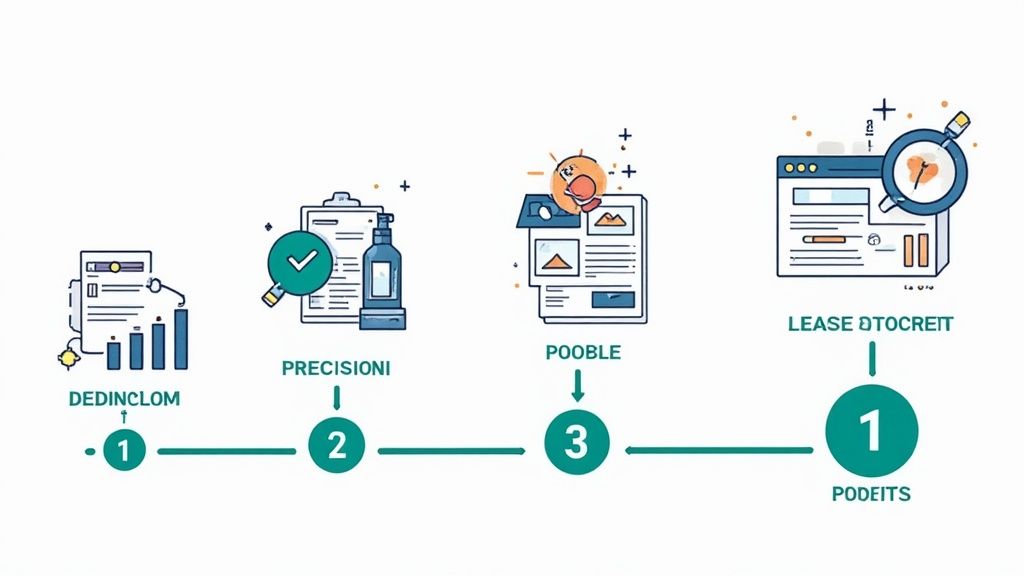Understanding Modern Customer Service Expectations

Instant access to information has completely shifted what customers want from support teams. People now seek more than just answers – they want genuine connections and real understanding during service interactions. For businesses, this means rethinking how they handle customer care. The personal touch has become essential – customers need to feel like individuals, not just ticket numbers.
The explosion of digital channels has created new ways for customers to reach out. Whether through Twitter, email, chat, or phone, people expect a smooth experience as they move between platforms. For instance, when a customer starts a conversation on social media and continues through email, they want the same level of service without having to repeat themselves. Missing this seamless connection frustrates customers and hurts their view of the support experience.
Quick responses have become non-negotiable for good service. Recent data shows just how much speed matters: 65% of customers want faster replies than they did 5 years ago, and 72% expect a response within 30 minutes. The numbers paint a clear picture – 60% of people feel satisfied when they get quick help, and 90% say immediate responses are crucial. "Immediate" means different things to different people though – 60% define it as 10 minutes or less. For more stats, check out Desk365's customer service research.
Key Expectations of Modern Customer Service
Beyond quick responses, customers look for several essential elements in their service experience:
- Proactive Support: Getting help before having to ask for it, like personalized suggestions based on past purchases
- 24/7 Availability: Having access to support at any time, which matters more than ever in our connected world
- Self-Service Options: Being able to find answers independently through help centers and guides
- Personal Touch: Receiving service that feels tailored to individual needs and history with the company
When companies understand and deliver on these core expectations, they build stronger relationships with customers. This focus on quality service isn't optional anymore – it's fundamental for any business that wants to keep growing and thriving.
Making Smart Use of Technology in Customer Care
Smart technology choices make a real difference in customer care quality. The key is finding practical ways to blend efficient digital tools with genuine human service. Getting this mix right helps businesses deliver excellent support while staying efficient.
Picking Tools That Fit Your Business
Every business has unique support needs. A new online store might do well with a basic chatbot for common questions, while bigger companies often need full CRM platforms with detailed customer tracking. The best approach is choosing tools that match your specific situation, team size, and customer preferences.
You might be interested in: How to master…
How AI Improves Customer Service
AI tools are changing how businesses handle customer support, but in practical ways. Research shows that by 2025, 85% of customer contacts will use automated systems. Right now, 56% of companies use AI chatbots, and 64% of customers prefer quick messaging over phone calls for basic help. These tools help by handling routine questions and keeping service available around the clock. Learn more about current trends in customer service here.
Connected Systems for Better Service
Many companies now use systems that link different support channels together. This means whether a customer sends an email, uses chat, or calls in, they get the same consistent help. Service agents can see all past conversations and customer details in one place, making it easier to give personal, helpful support.
Looking at What Technology Delivers
It's important to check if new technology is really helping. Looking at numbers like customer satisfaction (CSAT), first response time (FRT), and resolution rate shows what's working and what isn't. This helps companies spend wisely on tools that actually improve customer experiences.
Getting the Mix of Tech and People Right
Fast automated responses are great, but customers still want to talk to real people when things get complex. The best approach uses technology to make service more efficient while keeping the human touch where it matters most. This means giving service teams good tools while letting them focus on conversations that need personal attention. When done right, this creates service that's both quick and caring.
Building a Customer-Centric Service Culture

Great customer care starts with building a company culture focused on customers. It goes far beyond friendly service – it requires making customer success your north star and the ultimate measure of business performance. Let's explore the key elements needed to create this customer-focused environment.
Training for Customer-Focused Thinking
When training support teams, scripts and procedures are just the beginning. The real goal is helping employees understand customer needs on a deeper level. For instance, practice sessions might include group exercises where team members solve real customer problems together. This hands-on approach builds both skills and confidence, enabling staff to take ownership of each customer interaction.
Performance Metrics that Drive the Right Behaviors
Choosing the right metrics is critical for measuring customer care quality. While speed matters, focusing too heavily on handle times can hurt service quality. Better indicators include Customer Satisfaction (CSAT) scores, Net Promoter Score (NPS), and Customer Effort Score (CES). These metrics show how customers actually feel about their experiences and highlight areas for improvement.
Rewards and Recognition for Exceptional Service
People thrive on recognition when they deliver great service. Simple thank-you notes, performance bonuses, or advancement opportunities can reinforce excellent customer care. When teams celebrate service wins together, it strengthens the culture and reminds everyone that customer satisfaction drives business success.
Overcoming Resistance to Change
Shifting to a more customer-focused culture often meets resistance, especially in established companies. The key is clear, open communication about the benefits. Team workshops, regular meetings, and one-on-one conversations help address concerns. Show your team how these changes help both customers and employees succeed.
Building a Team that Prioritizes Customer Success
The foundation of customer-centric service is a team that genuinely wants to help others succeed. This starts with hiring people who naturally show empathy and problem-solving skills. Creating a supportive workplace where employees feel valued helps maintain this focus on customers. When the whole team shares this commitment to customer success, exceptional service becomes the norm rather than the exception.
Measuring and Improving Service Quality Metrics

Measuring customer care quality requires looking beyond basic metrics like call volumes. To truly understand how well you're serving customers, you need to track indicators that show the real impact on satisfaction and business growth. Let's explore the key metrics and how to use them effectively.
Key Performance Indicators (KPIs) for Customer Care Quality
These essential KPIs help paint a clear picture of service quality:
- Customer Satisfaction (CSAT): Quick post-interaction surveys reveal how happy customers are with their experience
- Net Promoter Score (NPS): Shows customer loyalty by measuring likelihood to recommend your company – high scores mean strong relationships
- Customer Effort Score (CES): Tracks how easily customers can resolve issues – lower scores indicate a smoother experience
- First Response Time (FRT): Measures speed of initial response, which customers consistently rate as highly important
- Resolution Rate: Shows the percentage of successfully resolved issues, indicating how effectively your team solves problems
Implementing a Comprehensive Measurement System
To track these metrics effectively, you'll need to collect data across all customer contact points. This often means connecting different tools and platforms to capture the full picture. For example, SupportMan helps by bringing Intercom ratings directly into Slack, making it easy for teams to see and discuss real-time feedback.
Turning Data into Actionable Improvements
Numbers alone don't drive progress – you need to use the data to make real changes. For example, if customers report high effort scores, consider improving self-service resources or simplifying support processes. When response times lag behind targets, look at adjusting staffing or giving agents better tools to respond faster.
Setting Benchmarks and Driving Continuous Improvement
Top performing teams regularly check their metrics against industry standards to spot areas for growth. They treat quality improvement as an ongoing journey rather than a fixed goal. This means consistently reviewing KPIs, analyzing patterns, and making adjustments to meet changing customer needs. Regular calibration helps ensure measurement tools stay relevant and aligned with both customer expectations and business goals.
Training and Empowering Customer Service Teams
A strong customer service team needs more than just friendly faces. Success comes from thoughtful training and giving representatives the tools and support to deliver excellent service. The key is focusing on both technical skills and personal development while creating an environment where team members can grow.
Essential Skills Development
The foundation of great service starts with core skills training. Representatives need to master active listening, clear communication, and problem-solving through hands-on practice. For instance, role-playing helps team members work through challenging scenarios before facing them with real customers. Learning company policies ensures everyone provides consistent service. This comprehensive training gives representatives the confidence to handle any situation.
The Power of Emotional Intelligence
Understanding and responding to customer emotions makes the difference between good and great service. Training in empathy, self-awareness, and relationship management helps representatives connect with customers authentically. When team members can read emotional cues and respond with genuine care, they build trust and turn difficult interactions into positive experiences.
Empowering Representatives for Success
When representatives have room to make decisions, they provide better service. Giving them guidelines for offering solutions, like approved discounts or special accommodations, lets them resolve issues quickly. This freedom shows trust in their judgment and motivates them to take ownership of customer satisfaction.
Ongoing Coaching and Performance Evaluation
Regular feedback keeps service quality high. One-on-one coaching sessions help representatives improve specific skills, while performance reviews track progress toward goals. Measuring success through Customer Satisfaction (CSAT) and Net Promoter Score (NPS) shows what's working and where to focus training. This continuous improvement cycle maintains service excellence.
Building a Motivated and High-Performing Team
The best service comes from happy employees who feel valued. Recognition programs, career growth opportunities, and team-building activities create an engaging workplace. When representatives enjoy their work and support each other, it shows in their customer interactions. Taking care of employee wellbeing leads directly to better customer experiences.
Creating Seamless Omnichannel Experiences
Providing excellent customer service requires meeting customers where they are – whether that's social media, email, phone, or chat. An omnichannel approach connects all these touchpoints while maintaining consistent quality and messaging across every interaction.
Understanding Omnichannel Customer Care
Picture this: A customer tweets about an issue, then follows up via email. With true omnichannel support, they never have to repeat themselves because agents can see the full conversation history. This creates a smooth, personalized experience that customers expect. The key is making every interaction feel like a continuation of the last one, not starting over from scratch.
Practical Approaches to Channel Integration
To build an effective omnichannel strategy, focus on these core elements:
- Customer Journey Mapping: Document each step of how customers interact with your business. This helps identify gaps and opportunities to create better experiences.
- Cross-Team Collaboration: Get your support, marketing and sales teams working together. When teams share customer insights and align their messaging, it creates a more consistent experience.
- Integrated Technology: Use tools that give agents a complete view of customer interactions across all channels. This helps them provide faster, more personalized support.
Eliminating Friction Points in the Customer Journey
Consider this common scenario: A customer tries to return a product online but can't find the right information. They call support and wait on hold, only to reach an agent who can't see their order history. This creates frustration at every step. Here's how to prevent these issues:
- Smooth Channel Switching: Make it easy for customers to move between channels without losing context
- Consistent Information: Ensure customers get the same answers regardless of how they contact you
- Proactive Support: Get ahead of issues by sending updates and offering self-service options
The Impact on Customer Care Quality
When you remove friction and connect all your support channels, you create better experiences that build customer loyalty and trust. Happy customers stay longer and spend more, driving business growth through strong relationships.
Ready to improve your customer support with seamless omnichannel service? Start your free trial of SupportMan today to bring all your customer interactions into one unified platform and help your team deliver consistently great service.


